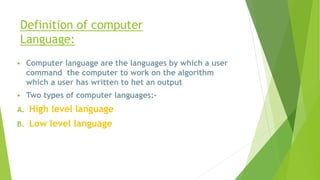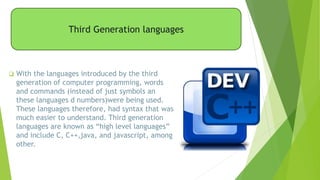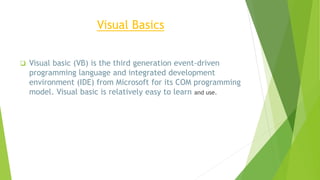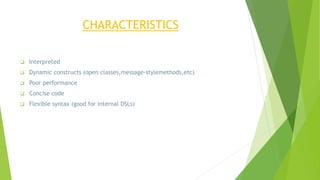Development of computer languages
- 1. Presented by: yash chauhan
- 2. Definition of computer Language: Computer language are the languages by which a user command the computer to work on the algorithm which a user has written to het an output Two types of computer languages:- A. High level language B. Low level language
- 3. A low level language is a programming language that provides Little or no abstraction form a computer’s instruction set architecture. A Lower language is used in two generation of computer. 1. First Generation 2. Second Generation Low level language
- 4. Represent the very early, primitive Computer languages that consisted entirely of 1’s and 0’s- The actual language that the computer understands (machine language). First Generation languages (1GL)
- 5. Represent a step up from the 1GL. Allow for the use of symbolic names instead of just numbers. Second generation languages are known as assembly languages. Code written in an assembly language is converted into machine language (1GL). Second Generation languages (2GL)
- 6. Direct memory management Little-to-no abstraction from the hardware Register Access Statements usually have an obvious correspondence with clock cycles Superb performance Characteristics of Low Level Languages
- 7. Advantages Computational speed is very Fast Directly understandable by Computer Disadvantages Development of a program in machine language is very time consuming. Error correction is very tedious Process
- 8. High level programming languages allow the specification of a problem solution in terms closer to those used by human beings. These languages were designed to make programming far easier, less error –prone and to remove the programmer from having to know the details of internal structure of a particular computer. This language is used in third generation High Level Languages (HLL)
- 9. Third Generation languages With the languages introduced by the third generation of computer programming, words and commands (instead of just symbols an these languages d numbers)were being used. These languages therefore, had syntax that was much easier to understand. Third generation languages are known as “high level languages” and include C, C++,java, and javascript, among other.
- 10. TYPES C++ VISUAL BASIC JAVA JAVASCRIPT
- 11. C++ C++ is statically typed, free-form , multi-paradigm, complied, general-purposes programming language. It is regarded as a “middle-level ” language, as it comprises a combination of both high level and low –level language features. LANGUAGE FEATURES:- Operators and Operator Overloading Templates Objects Polymorphism
- 12. Visual Basics Visual basic (VB) is the third generation event-driven programming language and integrated development environment (IDE) from Microsoft for its COM programming model. Visual basic is relatively easy to learn and use.
- 13. CHARACTERISTICS Interpreted Dynamic constructs (open classes,message-stylemethods,etc) Poor performance Concise code Flexible syntax (good for internal DSLs)
- 14. Advantages There are simple to adopt due to their English like structure of Language They are easy to maintain and debug. Disadvantages The program written in high level language are less efficient as they take more execution Time.
- 15. THANK YOU














